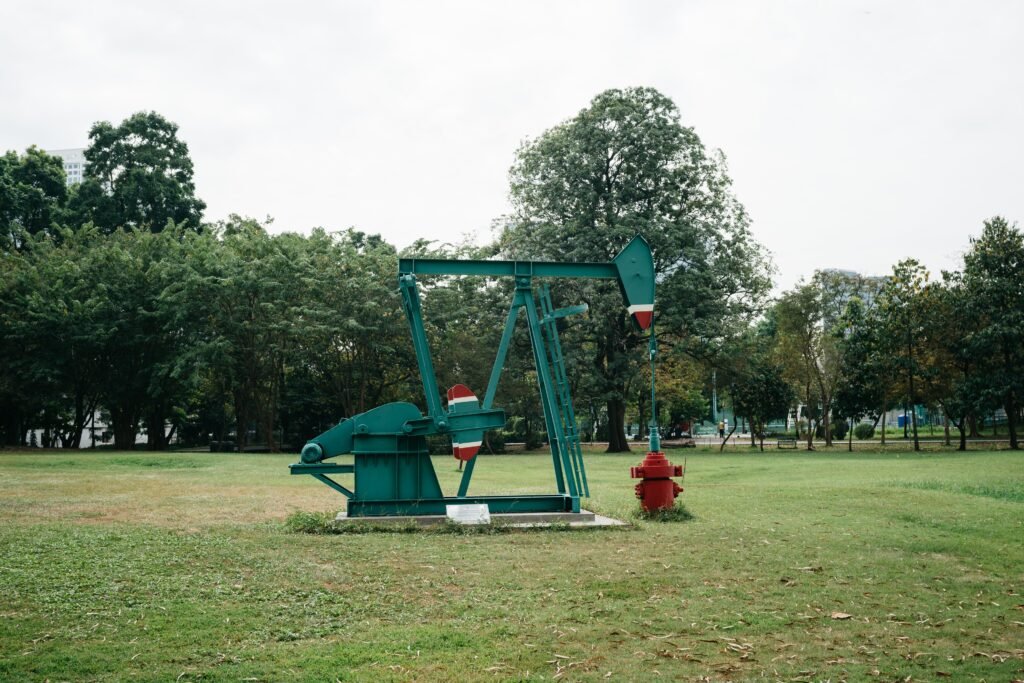Welcome to the fascinating world of offshore oil rig operations! In an industry that has long been associated with manual labor and traditional practices, there is a tidal wave of change on the horizon. Digital transformation is sweeping through the oil and gas sector, bringing with it a host of exciting technologies that are poised to revolutionize how we extract and produce one of our most precious resources: oil.
At the forefront of this transformation is automation. Imagine a future where towering rigs operate seamlessly without human intervention, utilizing advanced technologies to increase efficiency, reduce costs, and minimize environmental impact. This isn’t just the stuff of science fiction; it’s becoming a reality before our very eyes.
In this blog post, we will explore the trends and implications surrounding the future of oil rig automation. From emerging technologies to energy efficiency strategies, we’ll delve into how automation is reshaping offshore operations for good. So fasten your seatbelts (or rather hard hats), because we’re about to embark on an exhilarating journey into the world of automated drilling platforms!
The Future of Oil Rig Automation
Digital Transformation in the Oil and Gas Industry
The oil and gas industry, like many others, is undergoing a digital transformation. This shift towards embracing technology is driven by the need for increased efficiency, cost reduction, and improved safety measures. From exploration to extraction and production, digital innovation is reshaping every facet of the industry:
- One of the key drivers behind this transformation is data analytics. Companies are using advanced algorithms to analyze vast amounts of data collected from sensors placed throughout their operations. This enables them to gain valuable insights into everything from equipment performance to reservoir characteristics.
- Another aspect of digitalization in the oil and gas industry is remote monitoring and control systems. With advancements in communication technology, operators can now monitor offshore rigs from onshore locations. This not only enhances safety but also allows for real-time decision-making based on accurate information.
- Furthermore, artificial intelligence (AI) plays a crucial role in automating various processes within the industry. AI-powered systems can evaluate seismic data to identify potential drilling sites with greater accuracy than ever before. They can also optimize drilling parameters based on historical data, leading to more efficient operations.
- Cloud computing has also become an integral part of the digital transformation journey in this sector. By storing massive amounts of data securely in cloud-based platforms, companies are able to access it whenever needed without investing heavily in infrastructure.
This digital revolution sweeping through the oil and gas industry promises tremendous benefits for both companies and consumers alike. It streamlines operations while reducing costs and environmental impact – truly paving the way for a more sustainable future.
The Role of Automation in Offshore Oil Rig Operations
Automation has revolutionized various industries, and the oil and gas sector is no exception. In offshore oil rig operations, automation plays a crucial role in improving efficiency, safety, and productivity:
- One of the key areas where automation has made a significant impact is in drilling operations. Automated drilling systems can perform tasks with precision and accuracy that human operators may find challenging. These systems can analyze data in real-time to optimize drilling parameters such as speed, angle, and pressure. This not only increases efficiency but also reduces downtime due to equipment failures or human errors.
- Another important aspect of automation on oil rigs is remote monitoring and control. Advanced sensor technologies enable real-time monitoring of critical parameters like temperature, pressure, vibration levels, etc., ensuring early detection of potential issues before they escalate into major problems. Remote control capabilities allow operators to make adjustments from onshore locations if necessary.
- Automation also enhances safety by reducing the exposure of workers to hazardous conditions. Robotic systems can undertake dangerous tasks like inspecting pipelines or handling toxic substances with minimal risk to human life.
- Furthermore, automation facilitates better decision-making through data analytics. By collecting vast amounts of operational data from sensors and other sources, automated systems can generate valuable insights for optimizing processes and predicting maintenance needs accurately.
The role played by automation in offshore oil rig operations cannot be overstated. It improves efficiency while ensuring worker safety through remote monitoring and control capabilities. Additionally, advanced analytics help optimize processes for better decision-making based on accurate data analysis.
Emerging Technologies for Oil Rig Automation
The oil and gas industry is no stranger to technological advancements, and the race towards automation on offshore oil rigs is gaining momentum. As companies seek to increase efficiency, reduce costs, and improve safety, a variety of emerging technologies are being explored for their potential in revolutionizing oil rig operations:
- One such technology is robotics. Robotic systems can perform tasks that are traditionally carried out by human workers, eliminating the need for manual labor in hazardous environments. These robots can handle everything from routine inspections and maintenance to complex drilling operations with precision and accuracy.
- Another promising technology is the Internet of Things (IoT). By connecting various devices and sensors on an oil rig through a network, operators can monitor real-time data about equipment performance, environmental conditions, and worker safety. This allows for proactive decision-making based on actionable insights, leading to improved operational efficiency.
- Artificial intelligence (AI) is also playing a crucial role in oil rig automation. AI algorithms analyze vast amounts of data collected from sensors and historical records to identify patterns, predict failures or anomalies before they occur. This predictive maintenance approach helps optimize asset utilization while minimizing downtime due to unexpected breakdowns.
- Furthermore, 3D printing has emerged as a game-changer in the manufacturing processes of spare parts needed on offshore platforms. Instead of waiting weeks or even months for replacement components to be shipped from remote locations or fabricated off site, 3D printers can now produce these parts onsite within hours or days.
- Additionally, virtual reality (VR) has found applications in training programs where operators can simulate various scenarios without risking any physical harm. These immersive experiences allow workers to develop critical skills and enhance their situational awareness before stepping foot onto an actual oil rig platform.
Moreover, automation technologies such as autonomous drones have become instrumental in conducting aerial inspections across large areas quickly. These unmanned vehicles equipped with advanced cameras capture high resolution images, facilitating early detection of any potential issues or safety hazards.
Advantages and Challenges of Oil Rig Automation
Automation in the oil rig industry offers several advantages, but it also comes with its fair share of challenges. Let’s take a closer look at both sides of the equation:
- On the advantages front, one major benefit is increased safety. With automation taking over certain tasks, human workers are exposed to fewer hazards and dangerous conditions. This reduces the risk of accidents and injuries on offshore oil rigs.
- Another advantage is improved efficiency. Automated systems can perform repetitive tasks quickly and accurately, leading to higher productivity levels. This streamlines operations and allows for more efficient use of resources.
- Cost savings are also a significant advantage of oil rig automation. By reducing labor costs through automation, companies can save money in the long run. Additionally, automated systems can help minimize downtime by detecting potential issues early on, resulting in cost savings from maintenance and repairs.
- However, there are challenges that come with implementing automation in this industry as well. One challenge is the initial investment required to set up automated systems. Upgrading existing infrastructure or installing new technology can be costly upfront.
- Another challenge is ensuring proper training for workers who will be operating alongside automated systems. Workers need to acquire new skills to effectively collaborate with these advanced technologies while maintaining their roles within the overall operation.
- Cybersecurity is yet another challenge that cannot be overlooked when it comes to oil rig automation. As more processes become digitized and connected through networks, protecting sensitive data from cyber threats becomes critical.
- There may be concerns about job displacement due to increased automation on offshore oil rigs. While some manual jobs may no longer be necessary with full-scale automation implementation, there will still be a need for skilled technicians who can operate and maintain these sophisticated systems.
While there are clear advantages to automating oil rig operations such as improved safety measures, enhanced efficiency, cost savings potential; we must also acknowledge the challenges associated with initial investments, worker training, cybersecurity risks, and potential job displacement. It is crucial for companies to carefully evaluate these factors before investing in oil rig automation.
The Impact of Artificial Intelligence on Oil Rig Automation
Artificial intelligence (AI) has been making significant strides in various industries, and the oil and gas sector is no exception. With its ability to analyze vast amounts of data and make autonomous decisions, AI holds immense potential for transforming oil rig automation:
- One of the key areas where AI can have a profound impact is in predictive maintenance. By continuously monitoring equipment performance and analyzing historical data, AI algorithms can identify patterns that indicate impending failures or maintenance needs. This proactive approach not only reduces downtime but also optimizes maintenance schedules, leading to cost savings for operators.
- Moreover, AI can enhance drilling operations by optimizing parameters such as speed, pressure, and torque in real-time. By leveraging machine learning algorithms, AI systems can adapt to varying geological conditions and make precise adjustments that maximize efficiency while minimizing risks.
- Another exciting application of AI in oil rig automation is with robotic systems. These intelligent machines can perform tasks traditionally carried out by human workers with greater accuracy and efficiency. They reduce the risk of accidents on offshore rigs while improving overall productivity.
- However, integrating AI into oil rig operations does come with challenges. Data collection must be streamlined across different systems to ensure accurate analysis by AI algorithms. Additionally, there are concerns regarding cybersecurity as increased connectivity exposes rigs to potential cyber threats.
Nevertheless, the benefits offered by artificial intelligence outweigh these challenges. The future of oil rig automation lies in harnessing the power of advanced technologies like AI to optimize operations further and increase safety standards within the industry.
Predictive Maintenance and Optimization for Oil Rigs
Maintaining the efficiency and reliability of offshore oil rigs is crucial for the industry’s success. In the past, maintenance activities were typically performed on a fixed schedule or in response to equipment failures. However, with advancements in technology, predictive maintenance has emerged as a game-changer.
By utilizing various sensors and data analysis techniques, predictive maintenance enables companies to identify potential issues before they become major problems. This proactive approach not only minimizes downtime but also reduces operational costs associated with unscheduled repairs.
Optimization goes hand in hand with predictive maintenance by leveraging real-time data analytics to optimize rig performance. By continuously monitoring key parameters such as drilling speed, energy consumption, and equipment health, operators can make informed decisions to improve efficiency and reduce waste.
Implementing these technologies requires a robust data management system capable of handling massive amounts of information generated by sensors and other devices. Additionally, cybersecurity measures must be in place to safeguard sensitive data from potential threats.
As oil rigs become smarter through automation and artificial intelligence (AI), we can expect even more sophisticated predictive maintenance algorithms that adapt based on historical patterns and real-time conditions. This will further enhance safety levels while minimizing environmental risks associated with offshore operations.
The future of oil rig automation looks promising when it comes to predicting maintenance needs and optimizing performance. With advancements in technology like AI-driven analytics systems coupled with robust data management practices, oil companies have the tools they need to maximize productivity while reducing costs and environmental impact.
Cybersecurity and Data Management in Oil Rig Automation
In today’s digital age, cybersecurity has become a critical concern for industries across the board. The oil and gas sector is no exception, especially when it comes to offshore oil rig operations. With the increasing adoption of automation technologies, ensuring robust cybersecurity measures is essential to protect valuable data and prevent potential cyber threats:
- One of the key challenges in oil rig automation is managing vast amounts of data generated by various sensors and systems. This data includes real-time information on drilling operations, equipment performance, environmental conditions, and more. Effective data management practices are crucial to ensure that this wealth of information can be securely collected, stored, analyzed, and utilized to optimize rig operations.
- To address these challenges, industry players are investing in advanced cybersecurity solutions tailored specifically for offshore oil rigs. These solutions include strong encryption protocols to safeguard sensitive information from unauthorized access or tampering. Additionally, multi-factor authentication methods are implemented to enhance overall system security.
- Data backups are also vital components of effective data management strategies on oil rigs. Regularly backing up critical operational data ensures that even if a breach occurs or equipment fails unexpectedly, important information remains intact.
- Furthermore, rig operators employ network segmentation techniques where different sections of the network have limited connectivity with each other; this helps contain any potential breaches within isolated segments while keeping the rest of the system secure.
- Continuous monitoring plays a significant role in maintaining cybersecurity on oil rigs as well. Sophisticated intrusion detection systems help identify any suspicious activities or potential vulnerabilities promptly. By continuously monitoring network traffic patterns, operators can take swift action against threats before they escalate into major security incidents.
- Moreover, employee training programs focus on educating staff about best practices for maintaining cybersecurity vigilance.
Raising awareness about phishing attacks, social engineering tactics and other common attack vectors helps employees recognize potential risks and avoid inadvertently compromising sensitive systems or sharing confidential information with unauthorized individuals.
Smart Drilling and the Future of Oil Rig Operations
The oil and gas industry is constantly evolving, and one area that holds great promise for the future is smart drilling. This innovative approach to drilling operations integrates advanced technologies such as sensors, data analytics, and automation to optimize efficiency, improve safety, and reduce costs:
- One key aspect of smart drilling is the use of real-time data analysis. By collecting data from various sources such as downhole sensors, drilling equipment, and weather conditions, operators can gain valuable insights into the performance of their rigs. This allows them to make informed decisions in real-time, optimizing drilling parameters to maximize productivity while minimizing risks.
- Automation plays a crucial role in smart drilling by reducing human error and increasing operational precision. With automated systems controlling various aspects of the drilling process – including well placement, pressure management, and casing installation – operators can enhance efficiency while ensuring safer operations.
- Another important element of smart drilling is remote monitoring. Through connected platforms and IoT devices installed on offshore rigs, operators can remotely monitor critical parameters like temperature, pressure levels,
and equipment performance in real-time. This not only improves safety but also enables proactive maintenance by detecting potential issues before they escalate into costly failures or accidents. - Furthermore, “digital twins” are becoming increasingly prevalent in oil rig operations. These virtual models replicate physical assets such as drill bits or pumps so that engineers can simulate scenarios or test new strategies without disrupting actual operations. By using digital twins, specialists can experiment with different variables virtually which saves time, money, and reduces risk.
- As technology advances, digital twins will become more sophisticated enabling even greater optimization possibilities.
The integration of smart technologies is revolutionizing the way oil rig operations are conducted. Smart drilling offers immense benefits including enhanced safety, reduced downtime, optimal resource utilization, and improved decision-making capabilities. The future holds exciting prospects for this field as advancements continue to be made. Innovation-driven approaches like these will propel both efficiency gains within the industry and contribute to a more sustainable energy future.
Energy Efficiency Strategies for Offshore Oil Rigs
When it comes to offshore oil rigs, energy efficiency is not only important for reducing costs but also for minimizing the environmental impact of operations. With advancements in technology and automation, there are several strategies that can be implemented to enhance energy efficiency on these rigs:
- One strategy is the use of advanced monitoring systems to track and analyze energy consumption. By closely monitoring energy usage, operators can identify areas where improvements can be made and implement measures to reduce wastage. This could include optimizing equipment performance, adjusting operating parameters, or implementing energy-saving technologies.
- Another approach is the adoption of renewable energy sources such as solar or wind power. While this may not provide all the necessary energy requirements for an offshore rig, integrating renewable sources into existing systems can help offset some of the conventional fuel consumption.
- Efficient lighting solutions also play a significant role in reducing overall energy consumption on oil rigs. Implementing LED lighting systems can result in substantial savings while still ensuring adequate illumination for safety and operational needs.
- Additionally, regular maintenance and inspections are crucial for maintaining optimal efficiency levels. Equipment should be regularly serviced to ensure proper functioning and avoid any unnecessary waste due to malfunctions or leaks.
- Furthermore, implementing intelligent control systems that automatically adjust settings based on demand can optimize energy usage without compromising productivity or safety standards.
- Training employees on best practices regarding energy conservation is vital in instilling a culture of sustainability within offshore oil rig operations. Encouraging staff members to take ownership of their own actions by turning off lights when not needed or shutting down equipment during idle periods can contribute significantly towards improved efficiency levels.
By adopting these strategies collectively or individually as per specific requirements, offshore oil rigs have the potential to achieve greater overall energy efficiency while simultaneously reducing costs and minimizing environmental impacts.
Implications of Oil Rig Automation for the Industry and the Environment
The implementation of automation technologies in oil rig operations has far-reaching implications for both the industry and the environment:
- On one hand, it offers numerous benefits such as increased safety, improved efficiency, and reduced costs. These automated systems can perform tasks with precision and accuracy that surpass human capabilities.
- With automation, oil companies can minimize the risks associated with human error and accidents. By utilizing advanced sensors and monitoring systems, potential hazards can be detected early on, preventing disastrous consequences. This not only protects workers but also safeguards the surrounding environment from potential spills or leaks.
- Furthermore, automation enables optimized drilling processes by analyzing real-time data to make informed decisions. This leads to better resource management and more sustainable practices. Additionally, predictive maintenance algorithms help identify potential equipment failures before they occur, reducing downtime and minimizing environmental impact.
- Despite these positive implications, there are challenges that need to be addressed when it comes to oil rig automation. The displacement of manual labor due to increased reliance on technology raises concerns about job security for workers in this sector. Additionally, cybersecurity becomes a critical aspect as interconnected systems become vulnerable targets for hackers.
- However, considering the long-term benefits outweighing these challenges is crucial when discussing the implications of oil rig automation. As advancements continue to push boundaries in artificial intelligence (AI) applications within this industry, we can expect even greater optimization of resources while minimizing environmental impact.
Embracing oil rig automation will allow us to operate offshore drilling rigs more efficiently than ever before while mitigating risks associated with human error or accidents. It presents an opportunity for increased sustainability by optimizing processes through AI-driven analysis and predictive maintenance strategies.
Conclusion
In this rapidly evolving digital era, oil rig automation is poised to revolutionize the offshore oil and gas industry. The advancements in technology and the adoption of automation solutions are transforming the way offshore operations are conducted. From increased safety and efficiency to reduced costs and environmental impact, the implications of oil rig automation are profound.
The future of oil rig automation is filled with exciting possibilities. Emerging technologies such as artificial intelligence, predictive maintenance, smart drilling, and energy efficiency strategies will continue to shape the industry’s landscape. These technological advancements will enable operators to remotely monitor rig operations in real-time, optimize performance, minimize downtime, and enhance overall productivity.
However, along with these opportunities come challenges that need to be addressed effectively. Cybersecurity threats pose a significant risk in an interconnected ecosystem where critical data is shared across multiple platforms. Robust cybersecurity measures must be implemented to safeguard against unauthorized access or manipulation of sensitive information.
Additionally, proper data management practices are crucial for leveraging the potential of oil rig automation fully. Accurate data collection and analysis enable operators to make informed decisions regarding maintenance schedules, resource allocation, equipment upgrades or replacements which ultimately contribute towards maximizing operational efficiency.
Implementing energy-efficient strategies also plays a pivotal role in ensuring sustainability within the industry. By harnessing renewable sources of energy like wind or solar power on offshore rigs combined with advanced monitoring systems can significantly reduce carbon emissions while optimizing operational costs.
As we embrace these trends in oil rig automation going forward into the future; it’s important for stakeholders across all levels – from engineers to regulators –to collaborate closely and adapt their skills accordingly. This collaboration will facilitate knowledge sharing that drives innovation while addressing any concerns related to workforce displacement due to increased machine involvement.













![How to Improve Employee Welfare? [7 Ways] 14 How to Improve Employee Welfare](https://zoets.b-cdn.net/wp-content/uploads/2024/02/pexels-alexander-suhorucov-6457577-scaled-e1708707251724.jpg)